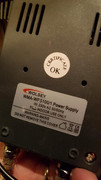@Merlin5 , I was just about to post a lot of the same suggestions that
@jpaul mentioned. Cover the basics that you can get at easily.
The warranty question is difficult because the circumstances are unusual. The reason why the support is free-of-cost to you is because the Government is making a bundle selling off chunks of the TV bands for mobile phone use. But at the same time the'y're having to fork out for all the work behind the scenes to get the TV transmissions for a whole country to mesh without clashing in a much-reduced transmission space, and also to fix reception issues that this work creates for some people in marginal areas.
It's very likely then that the Government through the national transmitter company
Arqiva would seek to limit its exposure to ongoing claims. They'd also want to provide the service for the lowest cost, and so something has to give. It's the warranty.
I've no idea how much aerial fitters in your neck of the woods might charge. Some offer a complete service with transparent pricing and using high quality materials with a long warranty support, but it costs more. That's where I stand. Personally I think it's good value for the customer to know that their installation is done to a high standard with parts that have an extended warranty from the installer lasting a total of five years. There are no price hikes during the job, and if something does fail (which can happen) then it's put right at no cost to them.
There are other installers who go the cheap route. There's the minimum of warranty that covers a basic 12 months, and although they quote a low price, it's often accompanied by the bump-ups where some or other 'problem' is discovered which they can fix but it wasn't in the original price. There are some national firms that train their installers how to do this. What they're relying on is that the householder will feel obliged to agree to extras once the job is underway.
A good indicator of the whether an installer is genuine or not is the quality of the cable they use. The decent guys use Webro WF100 or Triax TX100 or Philex/Nexans PF100. The rough-arses use RG6.
I'll tell you straight now, on day one of the installation there's very little performance difference for an average aerial installation. It's slightly more lossy, but at a cable run of under 20m there's not a lot in it. Physically though, the difference start to stack up. The centre core is steel with an anodised outer-coat of copper instead of pure copper. Steel rusts, copper doesn't. But that isn't the biggest problem.
On the outside the jacket is looser and, from the installs I've been called to put right, it goes brittle and cracks way sooner than good coax. Being loose also means that the inner and core slide about and sometimes move enough that the connection at a socket is broken. [Does that sound familiar?] The other big problem, especially with RG6 coax carrying power, is that the interference shield is made from Mylar (a metalised plastic not unlike crisp packets) and aluminium. As soon as there's a crack in the outer sheath and water gets in it reacts with the aluminium which starts to degrade to powder. This is accelerated in the presence of a voltage which speeds up oxidisation. The braid is required as part of the voltage-carrying electrical connection along with the core. If one or other corrodes through then all signal from any masthead amp will be lost. Where the braid is thinning then electrical resistance increases. Too much resistance will stop a masthead amp working.







